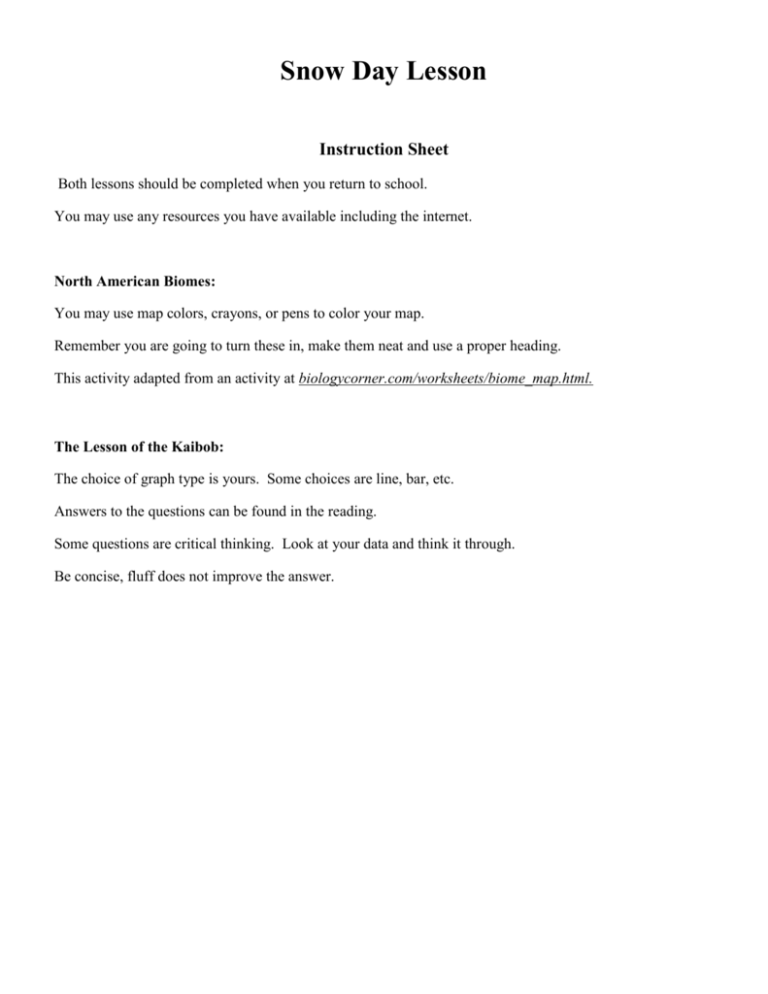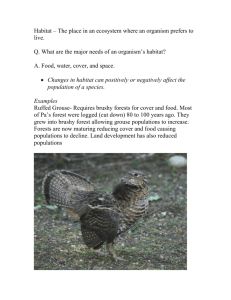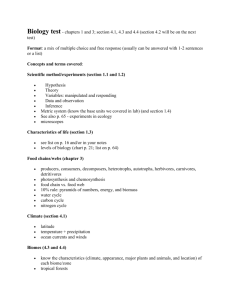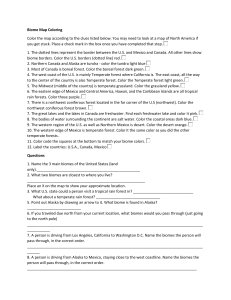Snow Day Assignment #2 - Bishop Lynch High School
advertisement

Snow Day Lesson Instruction Sheet Both lessons should be completed when you return to school. You may use any resources you have available including the internet. North American Biomes: You may use map colors, crayons, or pens to color your map. Remember you are going to turn these in, make them neat and use a proper heading. This activity adapted from an activity at biologycorner.com/worksheets/biome_map.html. The Lesson of the Kaibob: The choice of graph type is yours. Some choices are line, bar, etc. Answers to the questions can be found in the reading. Some questions are critical thinking. Look at your data and think it through. Be concise, fluff does not improve the answer. North American Biomes Color the map according to the directions listed below. You may need to look at a map of North America if you get stuck. There are biome maps on the web, use them. Try to get the borders of each biome as close as possible to where they are in nature. Place a check mark in the box once you have completed that step. 1. Solid lines denote the border between the U.S. and Mexico and Canada. Color the U.S. borders (dotted line) red. 2. Northern Canada and Alaska are tundra – color the tundra light blue 3. Most of Canada is boreal forest. Color the boreal forest dark green. 4. The west coast of the U.S. is mainly Temperate forest where California is. The east coast, all the way to the center of the country is also Temperate forest. Color the Temperate forest light green. 5. The Midwest (middle of the country) is temperate grassland. Color the grassland yellow. 6. The eastern edge of Mexico and Central America, Hawaii, and the Caribbean Islands are all tropical rain forests. Color those purple. 7. There is a northwest coniferous forest located in the far corner of the U.S (northwest). Color the northwest coniferous forest brown. 7. The great lakes and the lakes in Canada are freshwater. Find each freshwater lake and color it pink. 8. The bodies of water surrounding the continent are salt water. Color the coastal areas dark blue. 9. The western region of the U.S. as well as Northern Mexico is desert. Color the desert orange. 10. The western edge of Mexico is temperate forest. Color it the same color as you did the other temperate forests. 11. Color code the squares at the bottom to match your biome colors. 12. Label the countries: U.S.A., Canada, Mexico Questions 1. Name the 3 main biomes of the United States (land only).____________________________ 2. What two biomes are closest to where you live? __________________________________ Place an X on the map to show your approximate location. 3. What U.S. state could a person visit a tropical rain forest in? _________________ How about a temperate rain forest? ______________________ 5. Point out Alaska by drawing an arrow to it. What biome is found in Alaska? ____________ 6. If you traveled due north of your current location, what biomes would you pass through (just going to the north pole) ______________________________ 7. A person is driving from Los Angeles, California to Washington D.C. Name the biomes the person will pass through, in the correct order. ___________________________________ 8. A person is driving from Alaska to Mexico, staying close to the west coastline. Name the biomes the person will pass through, in the correct order. ___________________________ Tundra Desert Fresh Water Temperate Forest Tropical Rain Forest Temperate Grassland Salt Water Northwestern Coniferous Forest Boreal Forest (Taiga) Adapted from an activity at http://www.biologycorner.com/index.php M. Poarch – 2005 http://science-class.net Name__________________________ The Lesson of the Kaibab Purpose: 1) To Graph data on the Kaibab deer population of Arizona from 1905 to 1939. 2) Determine factors responsible for the changing populations. 3) Determine the carrying capacity of the Kaibab Plateau Background Information: The environment may be altered by forces within the biotic community, as well as by relationships between organisms and the physical environment. The carrying capacity of an ecosystem is the maximum number of organisms that an area can support on a sustained basis. The density of a population may produce such profound changes in the environment that the environment becomes unsuitable for the survival of that species. For instance, overgrazing of land may make the land unable to support the grazing of animals that lived there. Before 1905, the deer on the Kaibab Plateau were estimated to number about 4000. The average carrying capacity of the range was then estimated to be about 30,000 deer. On November 28th, 1906, President Theodore Roosevelt created the Grand Canyon National Game Preserve to protect the "finest deer herd in America." Unfortunately, by this time the Kaibab forest area had already been overgrazed by sheep, cattle, and horses. Most of the tall grasses had been eliminated. The first step to protect the deer was to ban all hunting. In addition, in 1907, The Forest Service tried to exterminate the predators of the deer. Between 1907 and 1939, 816 mountain lions, 20 wolves, 7388 coyotes and more than 500 bobcats were killed. Signs that the deer population was out of control began to appear as early as 1920 - the range was beginning to deteriorate rapidly. The Forest Service reduced the number of livestock grazing permits. By 1923, the deer were reported to be on the verge of starvation and the range conditions were described as "deplorable." The Kaibab Deer Investigating Committee recommended that all livestock not owned by local residents be removed immediately from the range and that the number of deer be cut in half as quickly as possible. Hunting was reopened, and during the fall of 1924, 675 deer were killed by hunters. However, these deer represented only one-tenth the numbers of deer that had been born that spring. Over the next two winters, it is estimated that 60,000 deer starved to death. Adapted from an activity at http://www.biologycorner.com/index.php M. Poarch – 2005 http://science-class.net Today, the Arizona Game Commission carefully manages the Kaibab area with regulations geared to specific local needs. Hunting permits are issued to keep the deer in balance with their range. Predators are protected to help keep herds in balance with food supplies. Tragic winter losses can be checked by keeping the number of deer near the carrying capacity of the range. Procedure: 1. Graph the deer population data. Place time on the X axis and "number of deer" on the Y axis DATA TABLE Year Deer Population Year Deer Population 1905 4,000 1926 40,000 1910 9,000 1927 37,000 1915 25,000 1928 35,000 1920 65,000 1929 30,000 1924 100,000 1930 25,000 1925 60,000 Adapted from an activity at http://www.biologycorner.com/index.php M. Poarch – 2005 http://science-class.net Data Analysis: Describe the relationship between the variables: _____________________________________________________________ _____________________________________________________________ _____________________________________________________________ _____________________________________________________________ Questions & Conclusions: 1. During 1906 and 1907, what two methods did the Forest Service use to protect the Kaibab deer? 2. Were these methods successful? Use the data from your graph to support your answer. 3. Why do you suppose the population of deer declined in 1925, although the eliminated of predators occurred? 4. Why do you think the deer population size in 1900 was 4,000 when it is estimated that the plateau has a carrying capacity of 30,000? 5. Why did the deer population decline after 1924?





